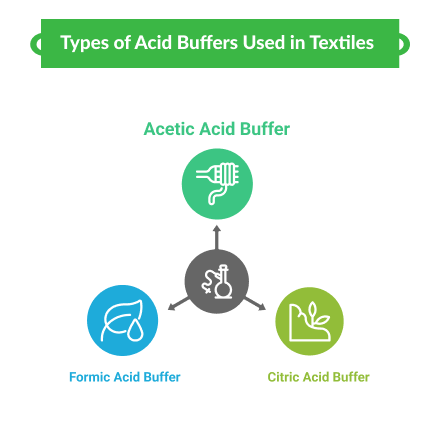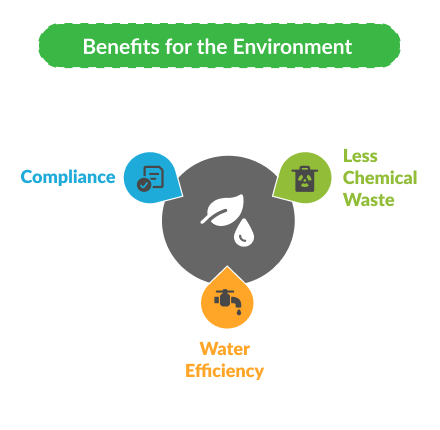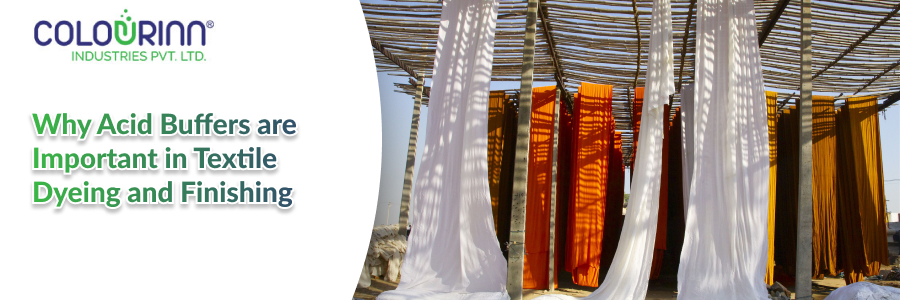In textile dyeing and finishing, pH control is key to vibrant colours and durable fabrics. This article will explain why acid buffer solutions like sodium acetate buffer solution and acetic acid buffer are essential.
From stabilizing dye baths to improving colour fastness and sustainability, we’ll cover their mechanisms, types, applications and environmental benefits. See how Colourinn Auxiliaries uses buffering solution expertise to deliver better textile results.
What are Acid Buffers in Textile Processing?
An acid buffer is a chemical solution that resists pH changes, keeping textile dyeing and finishing stable. By maintaining the optimal pH, buffers like acetic acid buffer allow dyes to bond with fibers, preventing uneven colouration or fabric damage.
These solutions typically combine a weak acid (e.g. acetic acid) and its conjugate base (e.g. sodium acetate) to neutralise excess acidity or alkalinity.
Why pH Matters
Dyeing and Finishing involve complex chemical reactions which are hypersensitive to ph changes. An acid buffer maintains a regular atmosphere, so:
- Uniform Dye Uptake: Stable ph means dye fiber bonding is way better, much less patchy.
- Fabric Protection: Prevents fiber degradation from intense ph levels.
- Process Efficiency: Minimises re-dyeing, saves time and resources.
Acid dyes are used on nylon fabrics, silk, and wool by putting them on with a sodium acetate buffer solution, created from a mixture of acetic acid as well as sodium acetate.
Types of Acid Buffers Used in Textiles
Several buffering solution types are used in textile processing, each for specific dyes and fibers. Here are the most common:

Acetic Acid-Sodium Acetate Buffer
The sodium acetate buffer solution, made from acetic acid and sodium acetate, is used for acid dyes on wool, silk and nylon. It has a pH of 4-5, ideal for ionic bonding between anionic dyes and cationic fiber sites. This buffer gives bright, even colours with good fastness.
Citric Acid Buffers
Citric acid buffers have a broader pH range (3-6) and are eco-friendly, reducing chemical waste. They’re used in reactive dyeing for cotton, to improve dye fixation and reduce environmental impact.
Formic Acid Buffers
Formic acid-based acetic acid buffer solutions are less common but work well for neutralising alkaline residues post-scouring or bleaching. They’re cost-effective and water-saving, in line with sustainability.
| Buffer Type | Ph Range | Applications | Benefits |
| Acetic Acid Sodium Acetate | 4-5 | Acid dyeing (wool, silk, nylon) | Vibrant colours, excellent fastness |
| Citric Acid | 3-6 | Reactive Dyeing (Cotton) | Eco-friendly. High dye fixation |
| Formic Acid | 3-5 | Neutralisation, finishing | Cost-effective, low water use |
Also Read on, Why Dyeing is an Essential Process in Textile Manufacturing
Role of Acid Buffers in Dyeing
Dyeing requires exact conditions for uniform colour and durability. An acid buffer does several jobs:
- Stabilising Dye Baths: Dyes work best at specific pH levels – especially acid and reactive dyes. Sodium acetate buffer solution inhibits sharp pH changes due to water impurities or chemical reactions, allowing consistent dye uptake. For instance, acid dyes on wool need pH 4-5 for ionic bonding.
- Improving Colour Fastness: Using a stable buffering solution strengthens dye-fiber bonds, making colors resistant to washing, light and wear. For textiles like sportswear and home furnishings where colour retention is critical this is important.
- Preventing Fiber Damage: Extreme pH can weaken fibers, making them brittle or losing their luster. An acetic acid buffer protects delicate fibers like silk by keeping the environment mildly acidic, so fabric integrity is preserved.
Acid Buffers in Finishing Processes
Textile Finishing enhances a textile’s feel, appearance and functionality. Acid buffer solutions are important here, too:
- Neutralising Alkaline Residues: Pre-treatment processes like scouring and bleaching leave alkaline residues that can interfere with finishing. A buffering solution like formic acid neutralises these residues so fabrics are ready for softeners or water-repellent finishes.
- Supporting Functional Finishes: Finishes like antimicrobial or flame-retardant coatings often require acidic conditions for application. An acid buffer ensures compatibility, so the finish works better and lasts longer.
Benefits for the Environment
The textile industry is getting more and more focused on sustainability and the use of acid buffer solutions can help with that.

- Less Chemical Waste: Accurate pH control prevents overuse of dyes and additives, reducing the toxicity of wastewater.
- Water Efficiency: Using eco-friendly buffers like citric acid can reduce the number of rinse cycles and save water.
- Compliance: Buffers that meet Regulations like ZDHC allow you to discharge wastewater safely.
The sodium acetate buffer solution from Colourinn is sustainably produced and uses organic acids while maintaining performance and reducing environmental impact.
Choosing the Right Acid Buffer
Choosing the right acid buffer depends on the type of dye, fiber and process used. Consider these factors:
- Type of Dye: Acid dyes need pH 4-5, reactive dyes need pH 5-6.
- fiber Sensitivity: Delicate fibers like silk need to be treated with milder acetic acid buffers as they are sensitive.
- Sustainability Goals: Go for citric or formic acid buffers for eco-friendly production.
Consult with Colourinn to get the right buffering solution for you.
Application Methods for Acid Buffers
Applying an acid buffer requires precision to get uniform results:
- Padding: Fabrics are immersed in a sodium acetate buffer solution and pressed to ensure even distribution.
- Exhaust Method: The Exhaust Method is used in batch dyeing by slowly introducing the buffer into the dye bath for absorption.
- Spraying: Good for precise application; but not widely used.
Maintaining the right ph balance is crucial to prevent over-buffering, which can cause colour fade and fiber weakness.

Challenges and Solutions
- Cost: Good buffers are expensive. Solution – Use advanced formulations like Colourinn to get the same results with lower dosing.
- Environmental Impact: Effluent load is also influenced by some buffers. Solution – Switch to eco-friendly alternatives like citric acid.
- Compatibility: Buffers must match dye-fiber systems. Solution- Run lab trials to optimise formulations.
Colourinn’s Promise of Quality Buffering Solutions
At Colourinn Auxiliaries, we realise the benefits of acid buffer solutions in textile dyeing and finishing. This particular manual indicates exactly how acetic acid buffer and also sodium acetate buffer solution control ph, boost colour fastness, protect fibers and also support sustainability. Our expertise provides you with vibrant, durable textiles which meet industry requirements.
Ready to upgrade your textile production with top-notch buffering solution products? Contact Colourinn Auxiliaries to check out our range of acid buffer solutions and see how we can transform your dyeing and finishing processes with quality and sustainability.
Frequently Asked Questions(FAQs):
Q1. What is an acid buffer in textile dyeing?
A. An acid buffer is a pH-stabilizing agent used in textile dyeing to maintain optimal acidity (pH 4–6). It ensures even dye absorption, prevents color variation, and enhances fabric quality.
Q2. Why is an acid buffer important for dye fixation?
A. Acid buffers provide a stable pH condition to enable dyes to firmly attach to the fibers, thus ensuring colorfastness, saving dye materials, and yielding efficient and bright colors. If pH levels fluctuate without the use of a buffer, the dye fiber bonds can weaken, setting the stage for color fading or bleeding.
Q3. Which acid buffer is best for textile dyeing?
A. Acetic acid and ammonium acetate are considered to be the best acid buffers for textile dyeing because they can maintain pH balance efficiently, restrict dye absorption, and ensure consistent color quality on the fabric.

